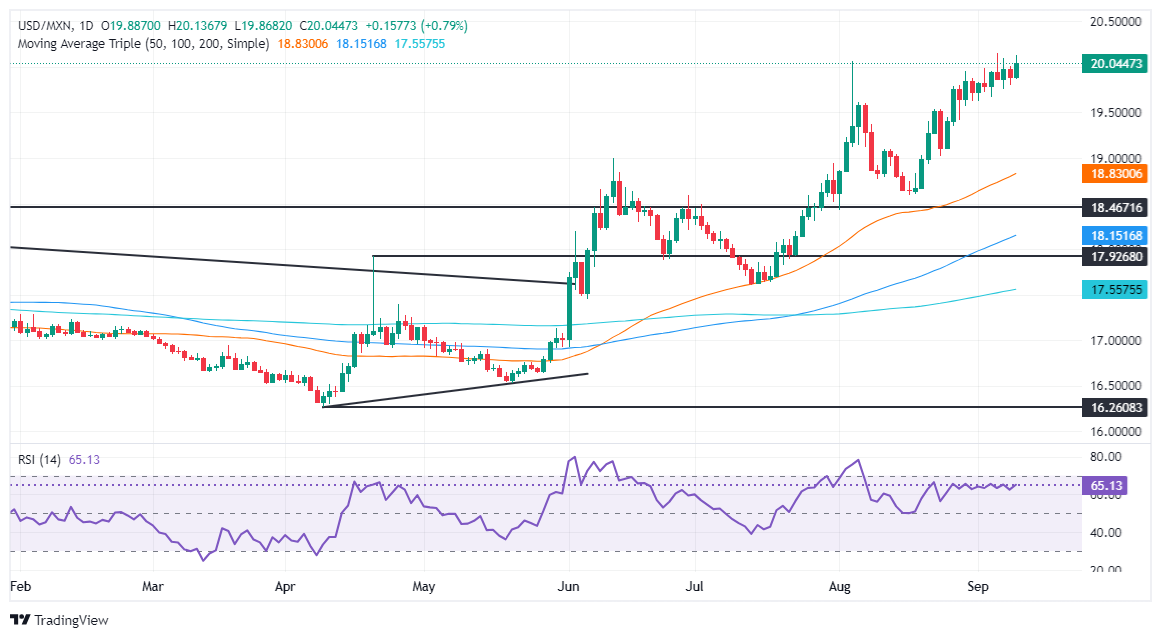- Mexican Peso dips over 1%; USD/MXN rises from 19.86 as Senate nears judicial reform vote.
- Foreign institutions and ratings agencies suggest economic risks and potential downgrade if reform is approved.
- Weaker-than-forecast inflation raises likelihood of Banxico rate cut on September 26; US Fed anticipated to cut rates by 25 bps soon.
The Mexican Peso depreciated over 1% against the American Dollar on Tuesday amid increasing tensions surrounding the Senate's approval of judicial reform. At the time of writing, the USD/MXN trades at 20.09 after bouncing off a daily low of 19.86.
The Mexican currency will remain volatile throughout the week as the Senate discusses the judicial reform. On Monday, a news article in El Sol de Mexico said Miguel Angel Yunez Marquez, Senator of the opposition party Partido Accion Nacional (PAN), would be the vote needed to approve the reform.
The Senate will begin formally reading the judicial bill at around 19:00 GMT. It’s expected that it will be voted on Wednesday or Thursday.
Foreign institutions had expressed that the reform could deteriorate the state of law and the country's credibility. Julius Baer warned that ratings agencies could change Mexico’s creditworthiness. They added their name to Morgan Stanley, Bank of America, JP Morgan, Citibanamex and Fitch by warning of the economic and financial impact regarding the approval of judicial reform.
Data-wise, the latest Consumer Price Index (CPI) reported on Monday showed that Mexican inflation was softer than expected, increasing the chances that the Bank of Mexico (Banxico) will cut interest rates at the September 26 meeting.
Kimberley Sperrfechter, an analyst at Capital Economics, commented that the latest inflation report and the likelihood of a Fed rate cut next week “mean that Banxico is on track to lower its policy rate by another 25 [basis points] at its meeting this month.”
Across the border, a Reuters poll revealed that 92 of 101 economists expect the Federal Reserve (Fed) to lower interest rates by 25 basis points (bps) at the September 17-18 meeting. The US economic docket has been scarce through the first couple of days, yet traders are eyeing the release of the latest inflation report. The data is expected to reassure investors that the Fed will cut rates at the upcoming meeting.
Daily digest market movers: Mexican Peso weakens on judicial reform expected vote
- Mexico’s inflation in August dipped below 5% on headline figures on an annual basis, while core inflation stood firm near 4% YoY.
- Mexico’s economic docket will gain traction on Wednesday, September 11, with the release of Industrial Production data. Later, the Senate is expected to approve the judiciary reform.
- September’s Citibanamex Survey showed that Banxico is expected to lower rates to 10.25% in 2024 and to 8.25% in 2025. The USD/MXN exchange rate is forecast to end 2024 at 19.50 and 2025 at 19.85.
- US CPI is expected to dip from 2.9% to 2.6% YoY in August, while core CPI is projected to remain at 3.2%.
- Data from the Chicago Board of Trade (CBOT) suggests the Fed will cut at least 108 basis points this year, up from 104.5 a day ago, according to the fed funds rate futures contract for December 2024.
USD/MXN technical outlook: Mexican Peso tumbles as USD/MXN rises above 20.00
The USD/MXN uptrend has extended above the 20.00 figure, with the exotic pair meandering around the figure after reaching a daily high of 20.13. Momentum hints that buyers are stepping in, as depicted by the Relative Strength Index (RSI) aiming upward and cracking the latest peak.
If the USD/MXN holds to gains above 20.00, the next ceiling level would be the YTD high at 20.22. On further strength, the pair could challenge the daily high of September 28, 2022, at 20.57. If those two levels are surrendered, the next stop would be the swing high at 20.82 on August 2, 2022, ahead of 21.00.
Conversely, if USD/MXN weakens further, the first support would be 19.50. A breach of the latter will expose the August 23 swing low of 19.02 before giving way to sellers eyeing a test of the 50-day Simple Moving Average (SMA) at 18.65.
Mexican Peso FAQs
The Mexican Peso (MXN) is the most traded currency among its Latin American peers. Its value is broadly determined by the performance of the Mexican economy, the country’s central bank’s policy, the amount of foreign investment in the country and even the levels of remittances sent by Mexicans who live abroad, particularly in the United States. Geopolitical trends can also move MXN: for example, the process of nearshoring – or the decision by some firms to relocate manufacturing capacity and supply chains closer to their home countries – is also seen as a catalyst for the Mexican currency as the country is considered a key manufacturing hub in the American continent. Another catalyst for MXN is Oil prices as Mexico is a key exporter of the commodity.
The main objective of Mexico’s central bank, also known as Banxico, is to maintain inflation at low and stable levels (at or close to its target of 3%, the midpoint in a tolerance band of between 2% and 4%). To this end, the bank sets an appropriate level of interest rates. When inflation is too high, Banxico will attempt to tame it by raising interest rates, making it more expensive for households and businesses to borrow money, thus cooling demand and the overall economy. Higher interest rates are generally positive for the Mexican Peso (MXN) as they lead to higher yields, making the country a more attractive place for investors. On the contrary, lower interest rates tend to weaken MXN.
Macroeconomic data releases are key to assess the state of the economy and can have an impact on the Mexican Peso (MXN) valuation. A strong Mexican economy, based on high economic growth, low unemployment and high confidence is good for MXN. Not only does it attract more foreign investment but it may encourage the Bank of Mexico (Banxico) to increase interest rates, particularly if this strength comes together with elevated inflation. However, if economic data is weak, MXN is likely to depreciate.
As an emerging-market currency, the Mexican Peso (MXN) tends to strive during risk-on periods, or when investors perceive that broader market risks are low and thus are eager to engage with investments that carry a higher risk. Conversely, MXN tends to weaken at times of market turbulence or economic uncertainty as investors tend to sell higher-risk assets and flee to the more-stable safe havens.
Information on these pages contains forward-looking statements that involve risks and uncertainties. Markets and instruments profiled on this page are for informational purposes only and should not in any way come across as a recommendation to buy or sell in these assets. You should do your own thorough research before making any investment decisions. FXStreet does not in any way guarantee that this information is free from mistakes, errors, or material misstatements. It also does not guarantee that this information is of a timely nature. Investing in Open Markets involves a great deal of risk, including the loss of all or a portion of your investment, as well as emotional distress. All risks, losses and costs associated with investing, including total loss of principal, are your responsibility. The views and opinions expressed in this article are those of the authors and do not necessarily reflect the official policy or position of FXStreet nor its advertisers. The author will not be held responsible for information that is found at the end of links posted on this page.
If not otherwise explicitly mentioned in the body of the article, at the time of writing, the author has no position in any stock mentioned in this article and no business relationship with any company mentioned. The author has not received compensation for writing this article, other than from FXStreet.
FXStreet and the author do not provide personalized recommendations. The author makes no representations as to the accuracy, completeness, or suitability of this information. FXStreet and the author will not be liable for any errors, omissions or any losses, injuries or damages arising from this information and its display or use. Errors and omissions excepted.
The author and FXStreet are not registered investment advisors and nothing in this article is intended to be investment advice.
Recommended content
Editors’ Picks

EUR/USD extends slide below 1.0300, touches new two-year low
EUR/USD stays under bearish pressure and trades at its lowest level since November 2022, below 1.0300 on Thursday. The US Dollar benefits from the risk-averse market atmosphere and the upbeat Jobless Claims data, causing the pair to stretch lower.

GBP/USD slumps to multi-month lows below 1.2400 on broad USD strength
Following an earlier recovery attempt, GBP/USD reversed its direction and declined to its weakest level in nearly eight months below 1.2400. The renewed US Dollar (USD) strength on worsening risk mood weighs on the pair as trading conditions normalize after the New Year break.

Gold benefits from risk aversion, climbs above $2,650
Gold gathers recovery momentum and trades at a two-week-high above $2,650 in the American session on Thursday. The precious metal benefits from the sour market mood and the pullback seen in the US Treasury bond yields.

These 5 altcoins are rallying ahead of $16 billion FTX creditor payout
FTX begins creditor payouts on January 3, in agreement with BitGo and Kraken, per an official announcement. Bonk, Fantom, Jupiter, Raydium and Solana are rallying on Thursday, before FTX repayment begins.

Three Fundamentals: Year-end flows, Jobless Claims and ISM Manufacturing PMI stand out Premium
Money managers may adjust their portfolios ahead of the year-end. Weekly US Jobless Claims serve as the first meaningful release in 2025. The ISM Manufacturing PMI provides an initial indication ahead of Nonfarm Payrolls.

Best Forex Brokers with Low Spreads
VERIFIED Low spreads are crucial for reducing trading costs. Explore top Forex brokers offering competitive spreads and high leverage. Compare options for EUR/USD, GBP/USD, USD/JPY, and Gold.
